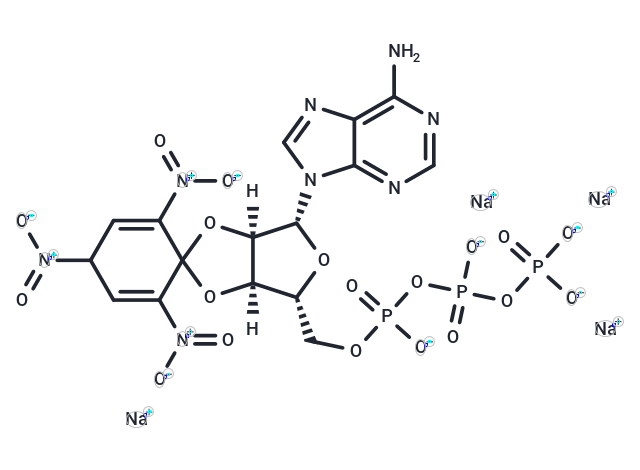- Remove All
 Your shopping cart is currently empty
Your shopping cart is currently empty
TNP-ATP sodium
TNP-ATP, a derivative of ATP, acts as an antagonist to the purinergic P2Y1, P2X3, and P2X2/3 receptors, demonstrating selectivity by showing lower inhibitory concentrations (IC50 = 6, 0.9, 7 nM, respectively) compared to the P2X2, P2X4, and P2X7 receptors (IC50 = 2, 15.2, >30 µM, respectively) in HEK293 cells expressing these human receptors. It effectively diminishes acetic acid-induced calcium influx in 1321N1 cells targeting P2X3 and P2X2/3 receptors (IC50 = 100 and 62 nM, respectively) and alleviates pain in a mouse model of visceral pain (ED50 = 6.35 µmol/kg). Moreover, TNP-ATP exhibits a notable fluorescence characteristic, with an emission peak at 547 nm after excitation at 403 nm, which enhances four-fold and shifts to 538 nm when bound to the insulin-degrading enzyme (IDE).

TNP-ATP sodium
| Pack Size | Price | Availability | Quantity |
|---|---|---|---|
| 5 mg | Inquiry | Backorder | |
| 50 mg | Inquiry | Backorder |
Product Introduction
| Description | TNP-ATP, a derivative of ATP, acts as an antagonist to the purinergic P2Y1, P2X3, and P2X2/3 receptors, demonstrating selectivity by showing lower inhibitory concentrations (IC50 = 6, 0.9, 7 nM, respectively) compared to the P2X2, P2X4, and P2X7 receptors (IC50 = 2, 15.2, >30 µM, respectively) in HEK293 cells expressing these human receptors. It effectively diminishes acetic acid-induced calcium influx in 1321N1 cells targeting P2X3 and P2X2/3 receptors (IC50 = 100 and 62 nM, respectively) and alleviates pain in a mouse model of visceral pain (ED50 = 6.35 µmol/kg). Moreover, TNP-ATP exhibits a notable fluorescence characteristic, with an emission peak at 547 nm after excitation at 403 nm, which enhances four-fold and shifts to 538 nm when bound to the insulin-degrading enzyme (IDE). |
| Molecular Weight | 806.20 |
| Formula | C16H13N8O19P3.4Na |
| Storage | keep away from direct sunlight | Powder: -20°C for 3 years | In solvent: -80°C for 1 year | Shipping with blue ice. |
| Solubility Information | H2O: Soluble |
Calculator
In Vivo Formulation Calculator (Clear solution)
Dose Conversion
Tech Support

Copyright © 2015-2025 TargetMol Chemicals Inc. All Rights Reserved.






